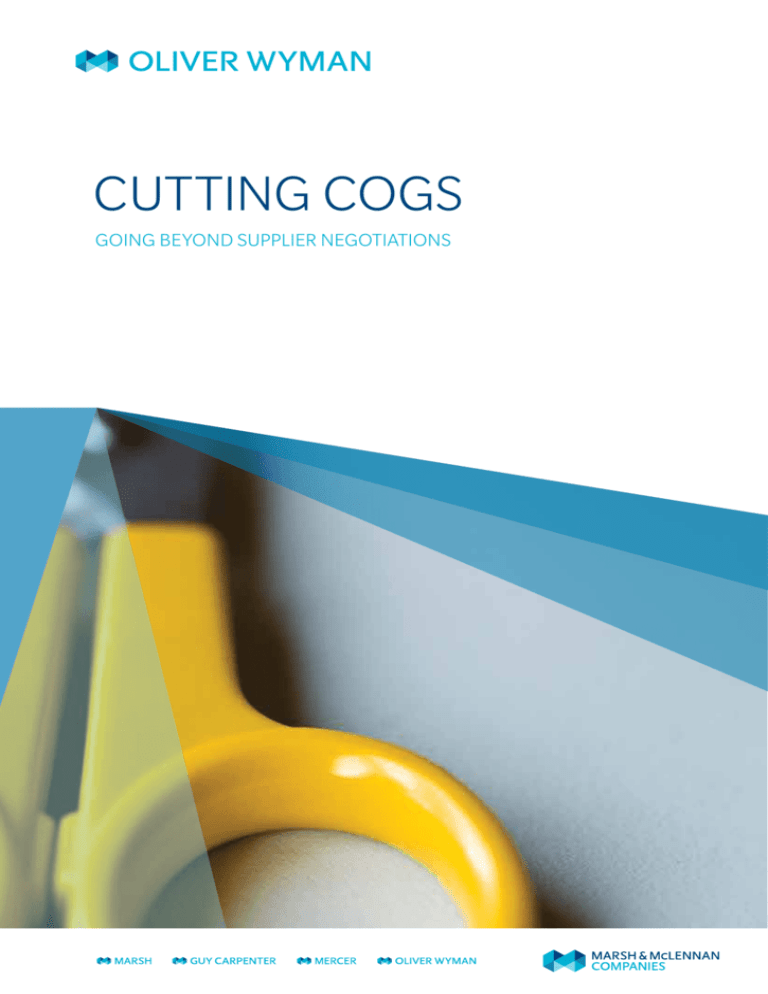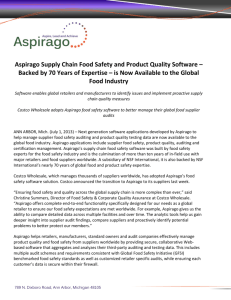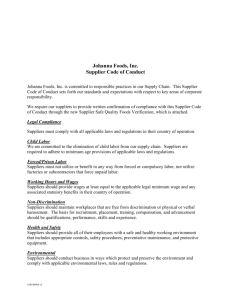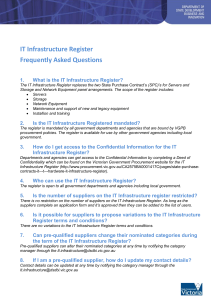
CUTTING COGS
GOING BEYOND SUPPLIER NEGOTIATIONS
2
CUTTING COGS
In today’s tough retail markets, reducing Cost of Goods Sold (COGS) is more important than
ever. Buying cheaper means better financial performance even when sales growth is hard
to come by, and while driving costs down requires little investment, the cash it frees up can
allow the business to invest in other areas.
Of course, reducing COGS is easier said than done. Retailers have always tried hard to
buy product as cheaply as possible, and most have redoubled their efforts in recent years.
Although weak demand and increased competition have encouraged manufacturers to
offer more attractive deals to maintain sales volumes, they can’t escape rising costs forever:
ultimately, they will need to pass them on to retailers. With many retailers experiencing
weak sales, it’s harder for them to promise suppliers volume growth tomorrow in exchange
for lower costs today.
But there remains significant scope for retailers to reduce bought-in costs – in some cases
by as much as 10% (see Exhibit 1). It takes a concerted effort over a 3–5 year period to reap
the full rewards, but it can greatly improve earnings performance.
Exhibit 1: Range of opportunity
% POTENTIAL SAVINGS
12
10
8
Higher Savings Potential (8%+) e.g. Hard Goods
• High proportion of complex, manufactured products
• Some spending with major brands, with limited previous
negotiations based on robust data and analytics
• Strong buyer power, growth opportunities for suppliers
• Fragmented supplier base, with no partner structure
• Untapped opportunities for low cost country soucing
6
4
2
0
Lower Savings Potential (4%+) e.g. Grocery
• High proportion of commodity items, e.g. fresh produce
• Extensive previous use of supplier negotiations based
on robust data and analytics
• Weak buyer power; limited supplier growth opportunities
• Consolidated supply base with clear supplier
partnership structure
• Low cost country sourcing offices in place
The key to achieving these significant, sustained reductions in COGS is to recognise that
achieving excellence in supplier negotiations is necessary, but not sufficient. Going beyond
negotiations and getting into the detail of suppliers’ underlying costs can yield multiple
opportunities for further cost reductions. However, capturing these savings requires a
transformation in the retailer’s relationship with its suppliers. In this article, we will briefly
discuss achieving excellence in supplier negotiations and then focus on going beyond this by
taking cost out with partner suppliers.
3
In this article, we will briefly discuss achieving excellence in supplier negotiations and then
focus on going beyond this by taking cost out with partner suppliers.
1. ACHIEVING EXCELLENCE IN
SUPPLIER NEGOTIATIONS
2. TAKING COST OUT
WITH PARTNER SUPPLIERS
Adopting sophisticated, systematised
approaches to deliver the maximum
results from each supplier negotiation
Building deeper relationships with a smaller
group of suppliers and working with them
to capture mutually beneficial savings
1
1. ACHIEVING EXCELLENCE IN
SUPPLIER NEGOTIATIONS
Many retailers have made large improvements in their negotiating capabilities over recent
years. It is no longer the case that suppliers are more likely to have the edge when it comes to
negotiating with retailers. Sales teams at suppliers are able to focus on much smaller ranges
of products compared to retail buyers who have to cope with hundreds of dissimilar ones.
However, retailers have access to a lot more data, which, if they are able to analyse it and
deploy it effectively, they can more than redress the balance in the negotiating process.
In many retailers, the information needed is scattered across unrelated, incompatible systems,
making it extremely difficult for time-pressed buyers to get hold of what they need when
preparing for negotiations with multiple suppliers. By working out how to provide buyers with
the most relevant and useful information in an accessible, user-friendly form, retailers can
ensure their buying teams make the strongest arguments possible and achieve the best results
from the negotiation process.
The earlier Oliver Wyman articles “Five Questions For Effective Negotiations”, “Negotiating
with Suppliers from a Position of Strength”, and “Smarter Arguments For Higher Profits”
(available on request) provide more detail on how a retailer can build the most effective
negotiating capability.
4
2. TAKING COST OUT WITH
PARTNER SUPPLIERS
For those retailers seeking to move beyond supplier negotiations and reduce costs further,
there are multiple large and untapped opportunities available. However, accessing them
requires such a shift in approach and mindset that success has eluded most retailers. It is deeply
ingrained in the psyche of retail buyers to use confrontational negotiation techniques
with suppliers, focused on maximising leverage to get the best possible deals. And yet,
getting at cost savings that are hidden deep in the end to end product supply chain necessitates
extremely close co-operation between retailer and supplier. That means operating in a true
partnership, openly sharing information and fairly dividing up the benefits.
This approach is standard practice in industries such as aerospace or automotive, where longterm supplier relationships are the norm and there is a strong sense of mutual dependency.
In our experience, this approach makes most retailers feel extremely uncomfortable – they
are reluctant to make long-term commitments with suppliers and often take the view that
“it’s none of their business” to understand how the products are made. As a result, to achieve
further COGS reductions they have tended to revert to ever more aggressive negotiation
approaches. In the long run though, these either fail to yield further savings or become
counterproductive as stronger suppliers prefer to work with less aggressive competitors and
weaker ones find they cannot cut margins further, ending up in financial difficulties or having
to cut corners on product quality or safety to meet the retailers’ demands.
SELECTING PARTNERS
It is neither practical nor sensible for a retailer to attempt to do this with its entire supply
base. For a start, the work involved tends to be both time consuming and complex. Even the
largest retailers will not have the bandwidth or capabilities to work in partnership with
hundreds of different suppliers. More appropriate is to select a smaller group, typically up to
50 suppliers. These should be selected from the group of the largest suppliers, but not all of
them will be appropriate. There are a number of important factors involved in selecting the
partners to work with:
•• Confidence that it is the right supplier for the longer term:
−− Those suppliers whose combination of product offering and commercial proposition
will consistently drive both sales growth and superior margins
−− For some suppliers, their brands are so strong and consumer loyalty so high that it
is inconceivable that they would not be a long term supplier. Their products are core
to the range architecture and will continue to be for the foreseeable future
−− In other cases, the supplier is uniquely positioned, for example, with a structural
advantage over its competitors in cost or freshness, or by providing unique products
•• Relationship with the supplier:
−− A high degree of mutual trust and openness is critical. Success will be hard to achieve
with suppliers that don’t show a strong willingness to co-operate
−− The desire to work in partnership needs to be reciprocated. It may not make sense to
partner with a supplier that has a much stronger relationship with a competitor retailer
5
Adopting the partnering approach doesn’t mean an end to confrontational supplier
negotiations. One of the challenges for retailers is to work out how to get both approaches
working effectively together. In fact, the partner selection process itself can be used as a way
to drive more from supplier negotiations. With the opportunity to become a partner at stake,
suppliers will need to put forward their best possible proposals, on the basis that partners
will grow share and non-partners will lose out.
This partner selection process presents a good opportunity to consider new suppliers, and
indeed new types of supplier. For example:
•• Could a wholesaler be replaced with a manufacturer?
•• Could a local supplier be replaced with a lower cost overseas source?
•• Are there suppliers with fundamentally superior propositions, say in terms of quality,
service level or speed to shelf?
•• Are there suppliers with unique innovations or products that could be exclusive?
REDUCING COSTS TOGETHER
The process of selecting partners, agreeing ‘more for more’ deals with them and systematically
shifting spend towards those partners will yield significant benefits. However, the more
significant savings opportunities will come from getting into the detail of the cost out work with
those partners. The biggest cost reduction opportunities are usually found in the following areas:
SUPPLY CHAIN
PRODUCT
SPECIFICATIONS
INTERFACE BETWEEN
RETAILER AND SUPPLIER
from raw materials to manufacturing and distribution
including materials, design,
accessories and packaging
efficiency of processes, optimal
order quantities
SUPPLY CHAIN
There are many ways that retailers can help their suppliers reduce costs in their supply
chains. For example, retailers often have greater buying power than their suppliers in certain
categories, such as specific raw materials or commodities such as fuel. A supplier which uses
the increased buying power of one of its retail customers to reduce its costs can achieve
benefits across all of its customers, and as a result the retailer involved should seek to capture
a disproportionate share of the savings. Distribution costs can be another area for significant
savings. For example, through optimising the use of backhaul whereby a supplier’s delivery
costs can be virtually eliminated by using the retailer’s empty vehicles that pass the supplier’s
factory on the way back to their own distribution centre.
6
PRODUCT SPECIFICATIONS
As far as product specifications are concerned, large retailers often have little understanding
of the cost implications of their demands. In fact, in many cases the supplier’s own sales teams
do not have a full understanding of the true costs associated with producing the products.
Take, for example, the manufacturer of silicone sealants selling to a DIY retailer who, in order
to hit a lower price point, made a small reduction in quantity of product in the tube believing
this would reduce the cost, not understanding the knock-on cost increase from disrupting
the manufacturing process. Or the retailer that produced a detailed packaging specification
for one of its own brand products but didn’t know that this would require the manufacturer
to use a non-standard, and more expensive, printing process, but where a small change,
unnoticeable to the end consumer, would mean a standard process could be used.
INTERFACE BETWEEN RETAILER AND SUPPLIER
Significant costs can arise from the way in which the retailer and supplier work together.
There can be multiple opportunities for streamlining the way that key processes operate,
including demand forecasting, order placement and replenishment, goods receipting and
payment. Minor adjustments on either side, for example improving how data is shared, can
lead to big improvements by reducing workloads and improving accuracy. Order quantities
can have a significant impact on a supplier’s production costs. In some cases the production
costs per unit of a full batch can be significantly less those for a part batch due to the effects
of set up costs and line downtime. Hitting the optimal order quantity, taking into account
all of the costs including production and storage can pay big dividends for certain product
categories – see Case Study 1.
All of these efforts by the retailer and supplier working together to reduce costs can
deliver large benefits for both. However, there is one important caveat: while this close
partnering with suppliers can yield big benefits, there is clearly a risk that suppliers will
find opportunities to take advantage of the reduced competitive pressure associated with
their partner status. As a result, retailers need to include mechanisms in their partner
agreements to prevent this. For example, by including ‘best price guarantees’ that give
the retailer the opportunity to find the best prices in the market and require the partner to
match these in order to retain its status. This can be achieved by running a regular process
of price benchmarking and competitive tendering or reverse auctions at the product level.
We have focused on the potential cost benefits of this approach, however there are a number
of other important benefits from cultivating these close relationships with core suppliers.
For example, in some categories which experience supply bottlenecks, building close
relationships with certain suppliers can lead to a significant competitive advantage in terms
of security of supply. In other cases there can be benefits from working together to achieve
improvements in sustainability or drive improvements in service levels, product quality or
developing unique products to give the retailer a competitive edge.
7
CASE STUDY 1
MULTINATIONAL DISTRIBUTOR
A multinational distributor was working closely with a key supplier to identify cost reduction
opportunities. Together, they spotted the potential benefits from optimising order quantities. The
products were made to order for the distributor in batches. Small orders meant the manufacturer
needed to set up a production line then shut down and clean it just a few hours later. Unit
manufacturing costs would reduce as the order size increased until a second production line was
needed which would increase unit costs again (Exhibit 2). Analysis showed that orders were not
being placed in a way that minimised production cost. Only 7% of orders were within the lowest
cost zone (Exhibit 3). The companies also factored in storage and delivery costs to minimise
total costs. Because of their partnership, the distributor could recognise which order
quantities minimised total cost, with the subsequent savings shared between the two parties.
Exhibit 2: Cost of different order quantities
UNIT COST (£)
1.10
Low
cost
zone
1.05
1.00
1st production line running
continuously, 2nd production
line making batches
0.95
0.90
0.85
0.80
Single production line
making batches
0.75
0
20
40
60
ORDER QUANTITY (THOUSANDS)
80
100
Exhibit 3: Order quantity distribution
PERCENTAGE OF ORDERS RECEIVED
30
20
Low
cost
zone
10
0
Under 10
10–20
20–30
30–40
40–50
ORDER QUANTITY (THOUSANDS)
8
50–60
60–70
Over 70000
(2nd prod. line)
PUTTING IT INTO PRACTICE
A systematic programme to reduce COGS can deliver significant gains, but it’s important
not to underestimate the amount of work required. It needs a significant effort over and
above the existing work of the retailer’s commercial teams, and these teams are often
already stretched with a multitude of other requirements – managing the range, running
promotions, managing prices, and so on.
When it comes to supplier negotiations, the challenge isn’t usually a lack of awareness or
understanding from buyers of what needs to be done, but a lack of time combined with a
lack of access to the analysis and tools that would enable them to develop the best possible
negotiating positions.
Successfully executing a ‘partner cost out’ programme is a much more significant challenge
for most retailers. It is likely to require a considerable change management effort, not only
with the retailer’s commercial team but also with the suppliers. There needs to be clear and
consistent communication of the programme, so that the suppliers understand what is
happening, why it is important and what is expected of them – supplier conferences and
direct communication from the retailer’s CEO form an important part of this. Internally,
everyone should be aligned on what needs to be done: how they should be working with
partner suppliers and what the expectations are from both sides. In addition, there needs to
be detailed tracking of activities to ensure the programme remains on course across all the
partner suppliers, combined with robust measurement of the benefits being delivered.
For those retailers with a degree of vertical integration, or those with low cost country sourcing
offices, they will have some in house experience further up the supply chain. However, in most
cases the skills required differ so much from those traditionally associated with retail buying
that it is necessary to bring in specialists with deep cost reduction experience (probably
from other industries), as well as putting in place a thorough programme of training and
development for the commercial team.
In summary, venturing beyond supplier negotiations into the world of ‘partner cost out’ isn’t
going to be a short, ‘one off’ project. It needs to be thought of as a multi-year programme,
with a focus on building and embedding the capabilities the organisation needs to ensure
the benefits are sustainable in the long term. Those retailers that are able to implement
successfully will be able to access reductions in COGS that would be unobtainable through
negotiations alone. The case study on the next page describes how one retailer approached
the problem, and was ultimately able to reap significant rewards.
9
CASE STUDY 2
EUROPEAN DIY RETAILER
CONTEXT
A multi-country, multi-format DIY retailer with historically high margins was facing an
increasingly difficult market, with new competitors entering. Its commercial teams had been
working hard to negotiate deals with suppliers – although synergies across countries were
very limited. A new management team came on board with a view that a reduction in COGS
of 8–10% was possible and decided to embark on a three-year programme.
APPROACH
The management team created a strategy to deliver the reduction in COGS over three
years – at the core of this was partnering with suppliers.
The initial focus was on the top 50 suppliers. This was kicked off with a supplier
conference, and was followed by detailed analysis to create negotiation ‘asks’ tailored for
each supplier and a structured process of negotiations with each supplier to obtain best
offers for re-alignment and future growth. This re-alignment and re-negotiation approach
was replicated across the wider supplier base, but with a lighter touch approach.
Regular meetings were held for the senior team to evaluate supplier offers and select
partners. Then three year agreements were put in place with all partners to lock-in the
benefits proposed by suppliers, and to facilitate the next stage.
Once partners were in place and spend had been largely consolidated to them, a cost down
programme was initiated to identify and deliver the next wave of savings – getting suppliers
to deliver on the commitments they made in their agreements.
In parallel, an intensive programme of tenders, e-auctions and product cost benchmarking
was launched to deliver further savings from non-partner suppliers and ensure partners
were providing the most competitive possible product pricing. In some categories, this
included moving to direct sourcing from lower cost countries.
Throughout the three years, a comprehensive programme management approach has
been in place to ensure activities remained on track and benefits were robustly measured
and captured. Additionally, specialists with cost reduction expertise were brought in from
outside the organisation to help drive the cost out work with partners and develop these
skills across the commercial team and tools were built to enable the commercial teams to
repeat the process and sustain the benefits over the long term.
THE RESULTS
The programme is on track to achieve its savings target of 8% in three years, despite
extremely challenging trading conditions that impacted the ability to offer growth to
suppliers. The COGS reduction programme has been a huge contributor to the company’s
financial performance over this period.
10
11
ABOUT OLIVER WYMAN
Oliver Wyman is a global leader in management consulting that combines deep industry knowledge with specialized
expertise in strategy, operations, risk management, and organization transformation.
In the Retail practice, we draw on unrivalled customer and strategic insight and state-of-the-art analytical techniques
to deliver better results for our clients. We understand what it takes to win in retail: an obsession with serving the
customer, constant dedication to better execution, and a relentless drive to improve capabilities. We believe our handson approach to making change happen is truly unique – and over the last 20 years, we’ve built our business by helping
retailers build theirs.
www.oliverwyman.com
CONTACTS
JAMES BACOS
NICK HARRISON
Global Retail Practice Leader
james.bacos@oliverwyman.com
+49 89 939 49 441
UK Retail Practice Leader
nick.harrison@oliverwyman.com
+44 20 7 852 7773
PAUL BESWICK
SIRKO SIEMSSEN
North American Retail Practice Leader
paul.beswick@oliverwyman.com
+1 617 424 3259
Central European Retail Practice Leader
sirko.siemssen@oliverwyman.com
+49 89 939 49 574
BERNARD DEMEURE
RICCARDO TRENTINI
French and Iberian Retail Practice Leader
bernard.demeure@oliverwyman.com
+33 1 45023 209
Italian and Turkish Retail Practice Leader
riccardo.trentini@oliverwyman.com
+39 02 305 771
Copyright © 2014 Oliver Wyman. All rights reserved.










